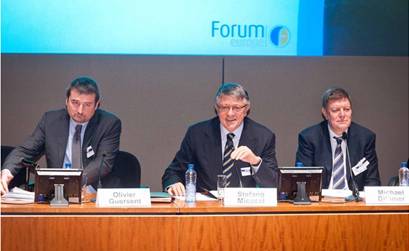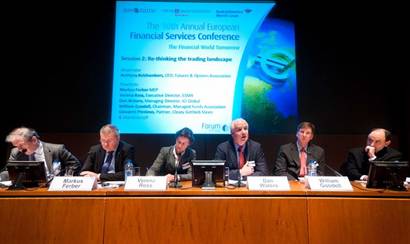Olivier Guersent, the head of cabinet for EU internal market commissioner Michel Barnier, delivered a keynote speech to present business leaders and said: "I don't believe we are going back to the 1930s. I believe that in the EU, and globally, we have the means in place to tackle the macro and the micro issues which face us. Yes, there is going to be a tough adjustment, and probably a limited recession. But not a slump."
Guersent, a former competition DG director, added, "Two crises are interacting with each other. The financial sector crisis of 2007-8 was not yet fully over – and the various safeguards to prevent a further such crisis not yet fully in place – when the sovereign crisis hit."Our European leaders have taken action to deal with the sovereign crisis, and global leaders in the G20 have laid down a clear roadmap for dealing with the financial crisis. But fears have been expressed that the severity of the medicine will take us back to the 1930s."
He said, however, that he did want to take "such a gloomy line", adding, "I want to accentuate the positive, and stress how much we have achieved, and how much we are coordinating internationally to put coherent reforms in place. "Our number one goal has to be to prevent further collapses of financial institutions, and failing that, find a way to organise bank failure in a way which prevents both massive taxpayer intervention – which in any case cannot be afforded another time – and a systemic chain reaction."
The official, who joined the commission in 1992, added, "We have done a lot already, both in the EU and globally. We are well on the way to meeting our G20 commitments. So what's missing? Well, in the EU, there is obviously a major absentee, and that is an EU-level bank resolution mechanism.
"Another thing which we need is an EU-level viewpoint on the structural issues in the banking sector."
This was the reason, he said, that Barnier recently announced the creation of a high-level expert group on structural aspects of the EU banking sector to be led by governor of the Bank of Finland Erkki Liikanen.
He told the packed audience that he wanted to identify two "key things" to work on. "The first is the interaction between financial regulation and investment in the real economy and, second, facilitating the access to capital of SMEs."
He added, "Yes, we need to do more. We need to look at the impact of capital requirements and especially risk weights, not just for sovereigns but for real economy investments."
He also called for the financial stability board to be "beefed up, to receive a permanent status and to undergo a governance review".
He said, "The FSB is here to stay and it needs to have the tools and the mandate to do its job, which is pushing countries to meet their G20 commitments. Enforcement is becoming a key word."We also need to make sure that our respective financial reforms don't lead to trade barriers and rolling back of trade liberalisation."
The second keynote address was delivered by Michael Dithmer, Permanent Secretary of State for Business and Growth, Denmark. He emphasized a series of priorities to be implemented.
Finance: renewal or retrenchment?
Banking and financial services are the lifeblood of economic development, and will be more crucial than ever as Europe seeks to reinvigorate its position in global markets. How successful has the financial services sector been in reforming its most controversial practices and reassuring public opinion that it is a responsible economic actor? |

